International Gothic Style
By the end of the 14th century, the fusion of Italian and Northern European art had led to the development of an International Gothic style. For the next quarter of a century, leading artists travelled from Italy to France, and vice versa, and all over Europe. As a consequence, ideas spread and merged, until eventually painters in this International Gothic style could be found in France, Italy, England, Germany, Austria and Bohemia.
Masters of illumination
The ancient art of book illumination was still the prevailing form of painting in France at the beginning of the 15th century. It reached new heights, however, in the work of the three Limbourg brothers, Pol, Herman, and Jean, exponents of the International Gothic style.
They came from Gelderland, a province of the Netherlands, but worked in France. They were the only other Gothic painters to take such orderly joy as that shown by Ambrogio Lorenzetti in the city and its environment, its people, and its rulers. The Limbourg brothers all died suddenly in 1416, probably of the plague.
The Limbourgs' joint masterpiece, Les Très Riches Heures, was commissioned by the wealthy and extravagant manuscript collector, the Duc de Berry. Les Très Riches Heures is one of a genre of 15th-century illustrated prayer books known as ``book of hours''. The ``hours'' were prayers to be said at one of seven hours of the day. A book of hours would naturally contain a calendar, and this became the opportunity for a display of the illuminator's talent. Sadly, this particular example was unfinished at the time of the Limbourgs' and the Duc de Berry's deaths.
Each month is marked by an enchanting scene, usually showing appropriate seasonal activities. In August, we see courtly lovers riding to hunt with their falcons, while the great white ducal castle gleams in the distance and the peasant swim happily in the winding stream. The blue upper part of the painting shows an astrological hemisphere. With its mixture of courtly refinement and everyday reality, this miniature is representative of many in the book.
The Garden of Eden was painted separately from the rest of Les Très Riches Heures and inserted into it later. It is a great enclosed circle showing the world as it was intended to remain before Adam and Eve's fall from grace. The whole story of the loss of Eden and human self-will is set graphically before us. Adam and Eve are finally ejected from the lush greenery of Eden unto a dangerous rocky shore. The Limbourgs' consciousness of tragedy is no less acute for being so chivalric in its manner. For all their elegance, they are as aware as all great artists that pain is our human lot.
<메리 여왕의 기도서>1310년경 에 이은
부르고뉴의 한 부유한 대공이 랭부르 형제의 공방에 주문해서 만든 기도서에 붙은 달력 <베리 공작의 기도서>1410년경. 샹티이 콩데 미술관
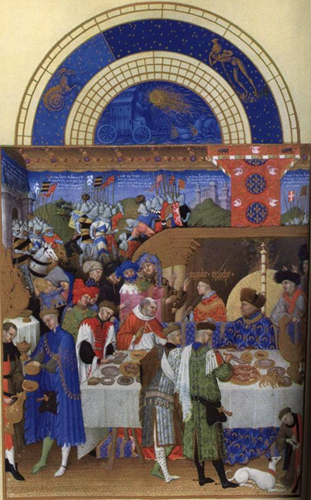
January 1월 염소,
The month of giving gifts (a custom which seems to have died out now). Jean de Berry himself can be seen on the right, wearing the brilliant blue robe.
선물을 주는 달.
오른편에 빛나는 푸른 의복을 입은 베리 공작이 , 왼편에는 염세가(은둔자),
Dans certaines familles, on ne celebrait guere Noel, bien que certains soient catholiques: on donnait un cadeau chaque annee qu'on appelait les etrennes. Ce mot remonte a l'usage Romain de par lequel le patron devait offrir une subside annuelle a ses clients. Il est possible que la television ait donne le dessus a la fete de Noel sur l'epiphanie. (comment from mmurphy@ernsty.co.uk)
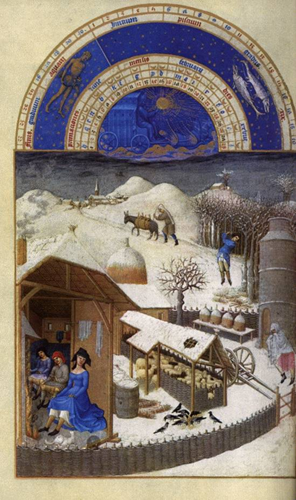
February 2월 물병,
Winter in a peasant village. The inhabitants of a farm are shown warming themselves by the fire, while in the background daily life - cutting wood, taking cattle to the market - goes on as normal.
겨울의 한 농가.
집 벽을 제거하고 실내풍경을 전하고 있다. 눈 덮인 풍경과 함께. 전면에 푸른 의복을 입은 귀부인은 불길에 다리를 드러내기 위해 치마를 들어올리고있다. 난로를 쬐고 있는 농부, 이것은 화가가 경험한 겨울을 보여주고 있다.

March 3월 물고기
The year's first farm work, sowing and ploughing and suchlike. The chateau in the background is that of Lusignan, one of the Duc's favourites.
3월의 전통적인 일은 포도를 재배하는 일. 한 해의 첫 농부의 일.
길 교차로에 4개의 장면이 경계 짓고, 고딕 작은 건축물을 기념탑이라 부른다.
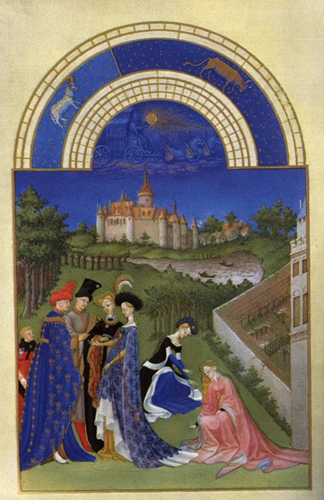
April 4월 산양,
The arrival of spring, hope and new life - the grass is green and a newly betrothed couple are exchanging rings in the foreground, accompanied by friends and family. The chateau is another one of the Duc's, that of Dourdan.
꽃을 수확. 봄의 시작. 희망과 새 생명. 잔디는 초록색.
왼편에는 약혼식 귀족 그룹, 우아한 두 여인이 잔디밭에 몸을 구부리고 있다. 벽으로 둘러싸인 과수원과 오른편에 장식무늬 건물의 투시원근법
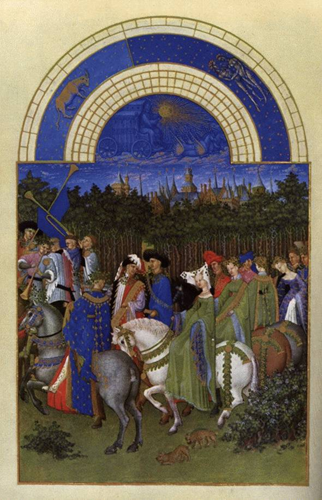
May 5월 황소
The May jaunt, a pageant celebrating the "joli mois de Mai" in which one had to wear green garments known as livrée de mai. The riders are young noblemen and women, with princes and princesses being visible. In the background is a chateau thought to be the Palais de la Cité in Paris.
산책.
왕자와 공주들과 젊은 귀족과 여인들. 붉은 안장과 회색말, 푸른 의복의 사람은 젊은 시절의 베리공작의 모습. 어린개들로 암시. 녹색드레스의 세부인은 5월 1일을 축하해주기 위해 관례대로 밝은 녹색을.
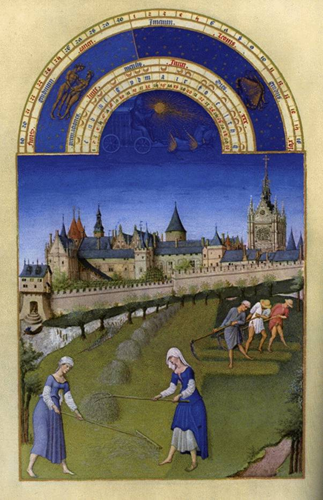
June 6월 쌍둥이
Harvest time - the peasants are mowing the meadow in unison, with the Hotel de Nesle, the Duc's Parisian residence, in the background. The building on the right is the Chapelle Royale, which is unchanged to this day.
수확시간, 풀 베어 말리기.
센느 강. 머리를 보호하기 위해 쓴 모자와 삼각숄에 의해 태양이 매우 강렬하게 내리쬐고 있음이 분명하다. 예술가들은 세밀한 작은 사람들로써 건축에 생기를 불어넣는다.
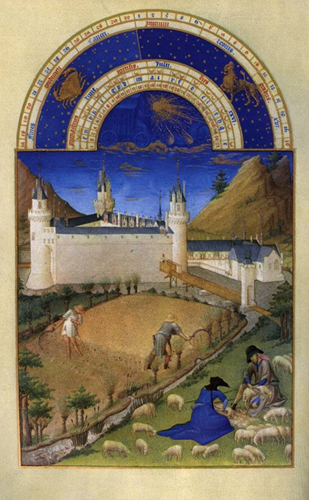
July 7월 게
More of the harvest; the sheep are being shorn and the hay is being reaped. The chateau behind them is that which formerly stood on the Clain at Poitiers.
더 많은 수확. 양들의 양털깍기,
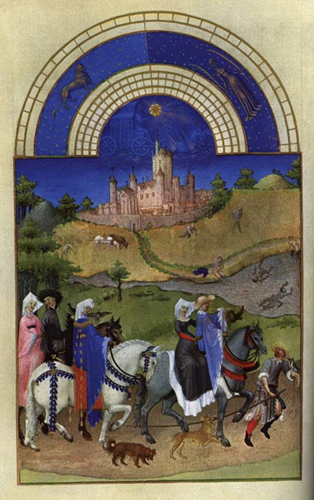
August 8월 사자
The month of hawking; the nobles, carrying falcons, are going hunting while in the background peasants are harvesting and swimming in the river. Behind them is the Chateau d'Etampes.
매사냥. 밀 두드리기.
베리공작을 위한 젊은 영주의 짝? 멀리서도 빛나는 크고 하얀 성. 농부들이 미역 감고 수영하고 있다. 적어도 한 명은 여자?
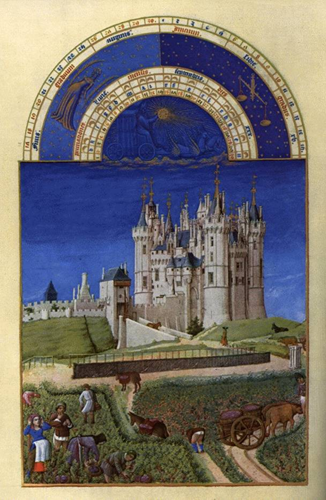
September 9월 처녀
Probably the most famous of the calendar images. The grapes are being harvested by the peasants and carried into the beautifully detailed Chateau de Saumur.
포도 수확. 가장 유명한 달력 이미지.
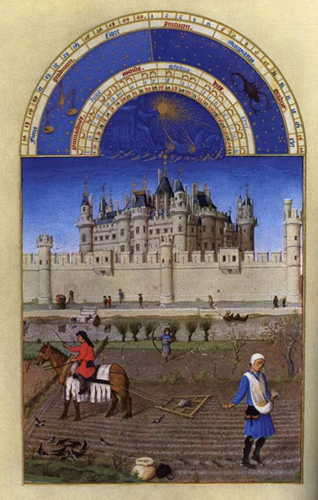
October 10월 천칭
Tilling and sowing are being carried out by the peasants, in the shadow of the Louvre - Charles V's royal palace in Paris.
파종, 세느강 좌측. 루브르 정면.
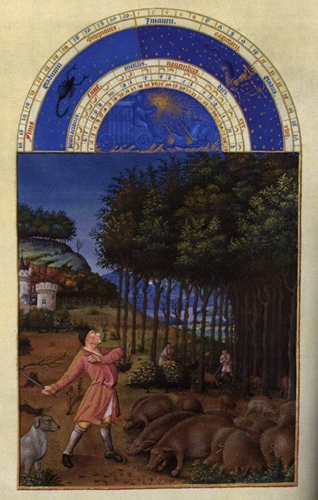
November 11월 전갈
This is the only calendar image executed by Colombe; the Limbourgs painted only the zodiacal tympanum above it. The picture shows the autumn acorn harvest, with a peasant knocking down throwing sticks to knock down the acorns on which his pigs are feeding.
도토리줍기. 도토리가 숙성하고 돼지고기는 더 충만하게 맛이 오른다.
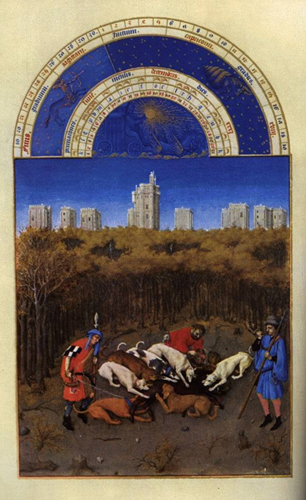
December 12월 사수
In the forest of Vincennes, fabled for its game, a wild-boar hunt has caught a boar which is being torn apart by the boarhounds. In the background is the Chateau de Vincennes, long a residence of French royalty.
돼지 죽이는 장면.
'History of Arts > Middle Age' 카테고리의 다른 글
| ICONagraphic de la vie CHRIST (0) | 2020.05.04 |
|---|---|
| 중세 : Giotto (0) | 2020.05.04 |
| 중세 (1) | 2020.04.27 |
| The Annunciation.<수태고지> (0) | 2007.06.25 |



